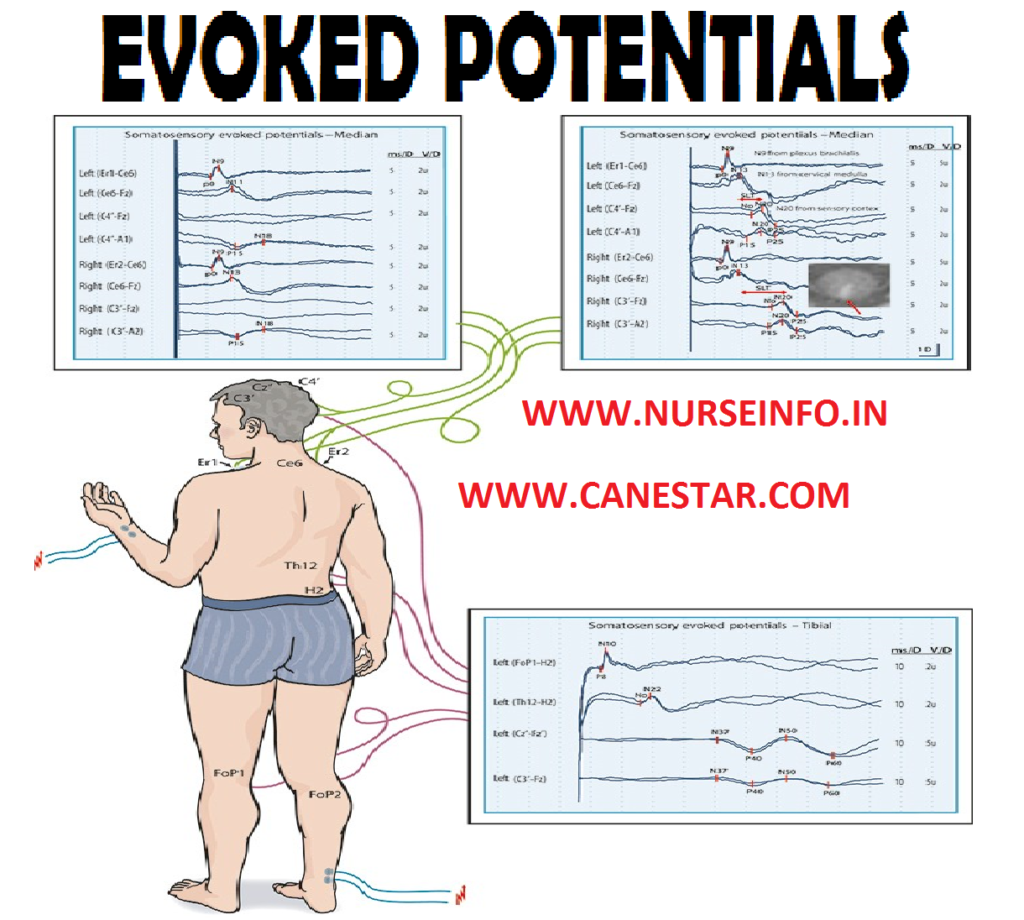EVOKED POTENTIALS – Definition, Purpose, Indication, Types of Evoked Potentials, Advantages, Client Preparation, Procedure and After Care
Evoked potentials involve the recording of electrical impulses generated by a sensory stimulus as it travels though the brainstem and into the cerebral cortex. Measuring evoked potentials is a sophisticated way of observing the status of sensory pathways as they enter the central nervous system, travel through the midbrain and reach the cerebral cortex
DEFINITION
Evoke potentials is a recording of electrical activity in central sensory pathways produced by placing electrodes over the scalp or the spine and using a computer to average and amplify the signal which results in characteristic pattern of wave from peaks that have approximate anatomic correlates
PURPOSE
- To observe the sensory pathway as they enter the central nervous system, travel through the brainstem and reach the cerebral cortex
- Evoked potentials also used during therapeutically induced comas such as barbiturate coma
- Evoked potentials used in the determination of the existence of brainstem or spinal cord injury in the traumatically injured patient
- It is used to assess the function of the cerebral hemispheres and the brainstem
- It is also used to assess blindness, deafness and brainstem injury
INDICATIONS
- Used in the diagnosis of multiple sclerosis
- Hypoxic coma
- Spinal cord injury
- Brainstem lesions
- Acoustic neuroma
TYPES OF EVOKED POTENTIALS
- Visual evoked responses (VER): it involves monitoring of the visual pathways through the brainstem and cortex in response to the patients viewing a shifting geometric pattern on a screen or placing a mask, which sends a flashing light stimulates over the eye
- Brainstem auditory evoked responses (BAERs): It involves monitoring of the auditory pathway through the brainstem and cortex in response to a rhythmic clicking sound sent through earphones placed over the patient’s ears
- Somatosensory evoked response (SSER): it involves monitoring of sensory pathways from the extremities ascending the spinal cord through the brainstem and into the cortex
ADVANTAGES
- Evoked potential studies can detect abnormalities even if the client is sedated or paralyzed with neuromuscular blocking agents
- Evoked potential studies are more reliable than clinical assessments in predicting neurological recovery in comatose, head-injured clients
CLIENT PREPARATION
- Explain the procedure and provide emotional support
- Head should be washed with soap
- Inform the client that he should be awake during procedure
- Do not apply oil over the head after the bath
- Provide good breakfast one hour before evoked potentials
- Provide hospital cotton dress to wear
PROCEDURE
- Place the client comfortably on the examination table
- Evoked potentials studies are carried out in the same fashion as EEGs
- Clients brain waves are monitored by giving various stimuli
- A variety of types of stimuli are used, such as auditory, somatosensory and visual
- Typical stimuli include flashing lights, buzzing tones and peripheral nerve stimulation
AFTER CARE
- Monitor the vital signs and neurological status
- Record the entire procedure in nurse’s record


